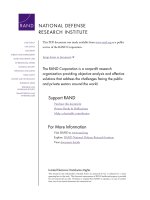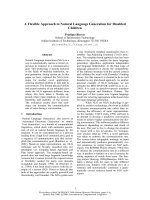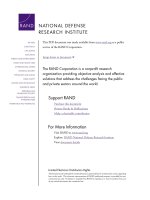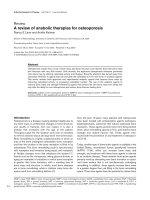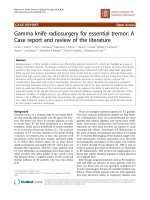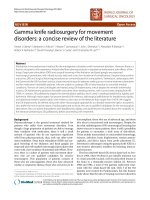Assistive technology for autistic children: A review
Bạn đang xem bản rút gọn của tài liệu. Xem và tải ngay bản đầy đủ của tài liệu tại đây (198.5 KB, 6 trang )
Int.J.Curr.Microbiol.App.Sci (2020) 9(7): 2170-2175
International Journal of Current Microbiology and Applied Sciences
ISSN: 2319-7706 Volume 9 Number 7 (2020)
Journal homepage:
Review Article
/>
Assistive Technology for Autistic Children: A Review
Divya Martolia* and Ritu Gupta
Dept of Family Resource Management, College of Community Science, Punjab Agricultural
University, Ludhiana-141004, Punjab, India
*Corresponding author
ABSTRACT
Keywords
Assistive
technology, Autism,
Rehabilitation,
Social
communication
Skill and Behaviour
Article Info
Accepted:
20 June 2020
Available Online:
10 July 2020
Autism spectrum disorder (ASD) is a condition related to mental development disability
that impacts how a person perceives and socializes with others, causing problems in
behaviour, social interaction and communication. The disorder also includes limited and
repetitive patterns of behaviour. Moreover, autism has broad variation in the type and
severity of disorder children experience and this disorder can occurs in any strata of
society, therefore it is known as “spectrum disorder”. Despite that ASD has long time
effect, however, proper medical treatment can aid to better recovery and functioning of the
children to interact within their social circle. Consequently, assistive technology has been a
core link in the chain that enables children with disabilities to lead a life where they enjoy
and exercise their rights rather than being destitute. This review paper focuses on
investigating the various technologies and its’ effect on special need children to improve
their performance in education and assist in their rehabilitation. This paper expound about
the assistive technology and its relation with autism disorder. The study is supported by
literature reviewed through various sources such as Google scholar, Springer, Pub Med
and books. In conclusion, assistive technologies work as imperative tool which seriously
boost autistic children confidence in independently functioning skill. Indeed, it also
improves the communication skill and promotes interaction, cognitive process and social
development. The framework of the study identifies the significance of technology, which
enhance the constructive skill of the autistic children. Furthermore, it highlights the
approach to emerging assistive device which initiate a better quality of life for the autistic
children.
Introduction
According to the Indian Scale Assessment of
Autism, approximately 2 million children
with autism are from India (Chauhan, 2019).
Autism spectrum disorder (ASD) is a
neurological development disorder that
affects
social
communication,
social
interaction, restricted and repetitive patterns
in behaviours and activities (American
Psychiatric Association 2013).Autism is
simply mental retardation, where people lack
in interest with other people in a group of
society. The exact cause of autism is still not
known, but researches indicate that it may be
caused due to the combination of genetic and
environmental factors. The symptoms of
autism in children appear during infancy
stage.
2170
Int.J.Curr.Microbiol.App.Sci (2020) 9(7): 2170-2175
Moreover, autism has broad variation in the
type and severity of disorder children
experience, therefore, it is also known as
“spectrum disorder”. As there are three types
of autism spectrum disorders identified:
Autistic Disorder (which is also called
"classic" autism), Asperger Syndrome and
Pervasive Developmental Disorder. Autistic
children are treated as social stigma in the
society and this make it difficult for the
children to survive where everyone is staring
them and jugging them for being the part of
this judgemental society. These days, the
children diagnosed with autism disorder have
grown at alarming rate.
Consequently, narrow focus, language issues,
lack of attention etc. hinders children growth,
following this, family also suffer because they
have to observe their child for 24 hours seeing
as he/she totally depends on their caretaker.
According to the Technology-Related
Assistance for Individuals with Disabilities
Act of 1988 (Public Law 100-407),
an assistive technology refers to any item,
piece of equipment, or product system,
whether acquired commercially, off-the-shelf,
modified or customized, that is used
to increase, maintain, or improve functional
capabilities of individuals with disabilities.
For example wheelchairs, eyeglasses, hearing
aids,
Braille
printers,
augmentative
communication
systems,
text-to-speech
software, voice recognition software etc.
An Assistive technology service is any
service that directly assists an individual with
a disability in the selection, acquisition, or use
of an assistive technology device. An assistive
technology serves two major purposes: to
augment an individual’s strengths, thereby
counter balancing the effects of the disability,
and to provide an alternative mood of
performing a task. Thus, the use of
technology allows students to compensate for
their disability or circumvent it entirely
(Lewis, 1998).
According to Konstantinidis et al., (2009) the
ICT (Information Communication and
Technology) sector over the last few years,
have created excellent applications and
platforms for the special need children
suffering from autism disorder to match their
pace with other fellow mates in learning
process. The use of technology and its
advance version is undoubtedly providing
better environment for stable learning. The
importance of ICTs in education calls upon
educationists to identify the challenges of
ICTs integration into teaching and learning.
The purpose is to improve the teaching and
learning quality for children with learning
disabilities such as autism (Mandina, 2015).
So, the idea behind this paper is to highlight
the assistive technologies used by autistic
children and its effect in their day to day life.
The specific objectives of the study are to
review the assistive technology used for the
children suffering from autism. And also to
study the impact of assistive technology in
their day to day life.
A review: Assistive technology for autistic
children
Diamond et al (2003) in their study analyzed
that tele-rehabilitation service is an emerging
method used to deliver rehabilitation services
to the children with autism. It creates least
restrictive environment for them to learn and
interact with others and reduces the time and
costs of offering rehabilitation services. It is
considered as a partial replacement of face-toface physical rehabilitation. Nowadays,
computer aided technology have imperative
role to operate the rehabilitation services.
2171
Int.J.Curr.Microbiol.App.Sci (2020) 9(7): 2170-2175
Table.1 Areas indicating autism symptoms
Sr. No.
1.
Areas
Social Interaction In Autism
2.
Communication In Autism
3.
Restricted behaviour
Indicators
Lack of peers interaction
Hard to correlate to their peers and other people’s actions
Avoid eye contact
Struggles to carry on conversation with people
Unresponsive to verbal prompts
Use modulation in their voice while speaking
Hard to understand non-verbal communication
Struggles with imaginative thought process
Show hyper or hypo behaviour to external stimulus
Repetitive behaviour, like throwing items or saying one
word again and again
Mood swing due to disruption
Talking excessively and endlessly about a particular
interest, often not allowing anyone else to speak
Source: Anonymous (2019)
La´nyiand Tilinger (2004) stated that the
platform of edutainment where addition of
entertainment props in education content such
as photographs or sketches of items used in
daily life displayed on the screen of the
desktop for people with autism. Indeed, the
use of computer aid technology help the
autistic to make out the difference on the
basis of the respective item size, color, type
etc. Furthermore, the interactive technology
using animated graphs provides a better
understanding and motivates them to
associate the items with sounds and words.
Likewise, the technology seems as boon for
the autistic children to construct their social
cognitive skills.
Assistive technology as boon for individuals
with disabilities, that aids to functional benefit
and make their task possible. The advance
tech-therapy paved way for children with
autism for stable learning environment as to
survive in the social circle. Consequently, the
experts state the use of various methods for
autistic children to improve their social
communication skills. Also, it has been
founded in the study of Collet-Klingenberg
(2008) that augmentative and alternative
communication known as best method
recommended to overcome the problems
related to social communication skill among
autistic children. The mode of picture
exchange communication system used to help
the learner with autism have stable learning
environment to understand and correlate the
pictures with their functioning.
Jowett et al., (2012)evaluated the video
modeling package and its effect on five year
old boy with autism disorder. The technology
used iPad- based video modeling to teach the
child basic numeracy skills. The outcome of
the study showed that there was positive
effect on the child ability to identify and write
1- 7 Arabic numerals. Further, the study
showed an affirmative effect of video
modeling package for teaching children with
autism disorder. The video modeling
technology undoubtedly, assists the autistic
children with constant learning environment
and helps them to stay motivated as well as
increase their attention power.
Murdock et al., (2013) conducted the study on
2172
Int.J.Curr.Microbiol.App.Sci (2020) 9(7): 2170-2175
use of an i-Pad to increase play dialogue of
pre-schoolers with autism spectrum disorder
in four pre-school children with autism
disorder. The participants were showed video
clips which depict pictures subsequently
producing scripted character dialogue. The
result revealed that three participants showed
increase in play dialogue behaviour, which
give a picture of the power of technology and
its benefit to the special need to cope up with
the lack of social cognitive behaviour.
Shrikumar (2015) in his article written to The
Hindu newspaper elucidated about how
technology helps the autistic children to cope
up with lack of social interaction and
restricted behaviour in social circle.
Moreover, technology is about concrete visual
along with voice such as AWAAZ OR BOL,
some of the applications used for language
development skill with audio and visual
component, picture exchange communication
method. These are friendly applications which
boost confidence, enhance constructive
language skill development and social
interaction in their peer group.
Renju and Megha (2016) in their study
revealed that children with autism are always
isolated and treated as destitute because of
their lack in social communication and
restricted behaviour. Although birth of
technology has been benefited to all the
humankind but it has been more special for
those group of people who are not as other
individuals in the society. Autism is a
neurological disorder, a person with autism
faces various problems in their day to day
activity. Consequently, Computer aided
technology enables them to improve their
social, cognitive skill and stabilize their
learning environment, this shows the impact
of technology motivating the children with
autism.
Hedges et al., (2018) in their study examined
the use of technology in supportive ways by
secondary students with autism. Around 472
adolescents with autism spectrum disorder of
high school were surveyed. Consequently, it
has been found that use of technological setup
at home and school environment help the
student to cope up with the obstacles they are
facing in their day to day activity. Further, the
technology aid in reduction in anxiety,
enhance independent functional skills and
engage them with other social skills.
Assistive tool for autistic children
ASSISTIVE
TOOL
Source: Renju and Megha (2016)
2173
Int.J.Curr.Microbiol.App.Sci (2020) 9(7): 2170-2175
In conclusion the autistic children are special
one with neurological disorder different from
normal individuals. They need extra care and
attention from their loved ones. In addition,
the technology has been a core link in the
chain that enables children with autism to
enjoy their life rather than being destitute.
Using ICT (Information Communication and
Technology) in effective way for therapy and
education of children with autism has been
proved a better approach for treatment. Many
researches have stated that autistic children
showed
sign
of
improvement
in
communication skill through mode of
illustration as they lack verbal skills and the
technology is set as boon for these special
group whom society seek as burden.
With respect to analysis of review of literature
related to technology for autistic children it
has been found that supportive technology
setup at school and home environment helped
a lot to the autistic children to work out on
their weak phase. Indeed, poor coordination
of neurological development has resulted in a
shortfall in social interaction and overall
cognitive development in autistic children.
Undoubtedly, assistive technology provided
an enhanced edutainment platform for autistic
children to upgrade their social skill,
behavioural skill, constructive skill for better
learning and for healthier life. There are some
friendly technologies such as BOL, AWAAZ,
VIDEOTAPING, BOARD MARKER and
many other smart interactive applications.
Certainly these applications assist children to
engage them with this kind of learning
platform to cope up with lack of functioning
and social skill.
References
American Psychiatric Association. 2013.
Diagnostic and Statistical Manual of
Mental Disorders, 5th Edition: DSM-5.
Washington, DC: Publisher.
Anonymous. 2019. Signs and Symptoms of
Autism Spectrum Disorders, National
Center on Birth
Defects
and
Developmental Disabilities, Centers for
Disease Control and Prevention..
Retrieved from www.cdc.gov › ncbddd ›
autism › signs.
Chauhan, A., J. K. Sahu, N. Jaiswal, K.
Kumar, A. Agarwal, J. Kaur, S. Singh
and M. Singh. 2019. Prevalence of
autism spectrum disorder in Indian
children: a systematic review and metaanalysis, Neurol India, 67(1) : 100-104.
Collet-Klingenberg, L. (2008). Overview of
Picture Exchange
Communication
System (PECS) for children and youth
with autism spectrum disorders.
Madison, WI: National Professional
Development Institute on ASD, The
Waisman Center, The University of
Wisconsin.
Diamond, B., G. Shreve and J. Bonilla. 2003.
Tele-rehabilitation, cognition and useraccessibility, Neuro Rehabilitation,
18(2):171-177.
Hedges, S. H., S.L. Odom, K. Hume and A.
Sam.2018. Technology use as a support
tool by secondary students with autism,
Autism, 22(1): 70-79.
Jowett, E.L., D.W. Moore and A.
Anderson.2012. Using an iPad-based
video modelling package to teach
numeracy skills to a child with an
autism spectrum disorder, Dev.
Neurorehabilitation, 15 (4):304-312.
Konstantinidis, E., A. Luneski, C. Frantzidis,
C. Pappas and P. Bamidis.2009. A
proposed framework of an interactive
semi-virtual environment for enhanced
education of children with autism
spectrum disorders, The 22nd IEEE
International Symposium on ComputerBased Medical Systems (CBMS).
La´nyi, C. S. and A. Tilinger.2004.
Multimedia and virtual reality in the
rehabilitation of autistic children,
2174
Int.J.Curr.Microbiol.App.Sci (2020) 9(7): 2170-2175
Springer-Verlag Berlin Heidelberg,
3118: 22–28.
Lewis, L. B. 1998. Assistive technology and
learning disabilities: today’s realities
and tomorrow’s promises, J Learning
Disabilities, 31(1):16-26.
Mandina, S. 2015. Integrating ICTs into the
environmental science primary school
classroom
in
Chegulu
district,
Zimbabwe: problems and solutions,
European
J
Sci.
Mathematics
Education, 3(1): 90-96.
Murdock, L., J. Ganz, and J. Crittendon.
2013. Use of an ipad play story to
increase play dialogue of preschoolers
with autism spectrum disorders, J
Autism Dev. Disorder, 9:2174–2189.
Renju, K. and C. Megha. 2016. Technology
and autism: is technology a boon for
autistic children? int j computer sci
trends tech., 4(3): 343-345.
Shrikumar, A. 2015.Technology helps in
autism, The Hindu. Retrieved from
/>roplus/technology-helps-inautism/article7057808.ece,
www.govinfo.gov>content>pkg>STAT
UE 102: Public Law 100-407.
How to cite this article:
Divya Martolia and Ritu Gupta. 2020. Assistive Technology for Autistic Children: A Review.
Int.J.Curr.Microbiol.App.Sci. 9(07): 2170-2175. doi: />
2175

